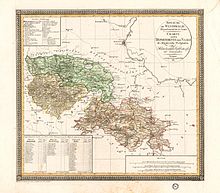Halberstadt district
The Halberstadt district was an administrative unit in the Saale department in the Kingdom of Westphalia . It was formed by the Royal Decree of December 24, 1807 and existed until 1813.
territory
Most of the district consisted of the former Prussian principality of Halberstadt on this side of the rift ditch. The district was bordered by three rivers, next to the Bruchgraben by the Ecker in the northwest against the Goslar district and in the southwest by the Bode against the Principality of Anhalt-Bernburg . In the south, the district shared the border with the Blankenburg district .
In 1807, 79,443 people lived in Halberstadt on 22.3 square meters. In 1811 there were 77,100 people living in 24.13 square miles . Of these, 2,695 were Catholic, 969 were Reformed and 551 were Jewish. The rest of the population had an evangelical creed.
organization
The district was headed by a sub-prefect . The sub-prefect of the Halberstadt district was also the chief prefect of the department.
Messrs Jäger, Delius, Grützmann, Kruse, Niemeyer, Ramdohr, Rohbrade, Rosenthal, Waldmann, Wahnschaffe and Weidemann formed the district council to control the tax lists.
Courts of justice were in Cochstedt, Croppenstedt, Dardesheim, Dedeleben, Gatersleben, Grüningen, Hesse, Horneburg, Osterwick, Schlanstedt, Schwanebeck and Wegeleben and two each in the city of Halberstadt and Aschersleben.
Cantonal division
The district was divided into 16 cantons with 72 communes on December 24, 1807:
| Canton (main town) | Kantonmaire | population | Area in mi² |
|---|---|---|---|
| Halberstadt | Friedrich Carl Cunow | 13,088 | 0.85 |
| Aschersleben-Land | Johann Christian Degener | 2,334 | 1.83 |
| Aschersleben city | Franz Christian plum | 7,758 | 0.21 |
| Cochstedt | Müller | 3,371 | 1.74 |
| Croppenstedt | Dösel | 4,767 | 2.04 |
| Dardesheim | Michaelis | 3,455 | 1.47 |
| Dedeleben | Heinrich-Ludwig von Hüneke | 3,858 | 1.66 |
| Gatersleben | ? from Oppen to Siede | 3.233 | 1.63 |
| Groeningen | Georg Wilhelm Heyne on Hakeborn, Heynburg, Gröningen and Dalldorf, former royal councilor of Gröningen and Subkau (West Prussia) | 4,041 | 1.57 |
| Halberstadt-Land ( Wehrstedt ) | Anton von Branconi | 4,568 | 2.97 |
| Hesse | black | 3,591 | 1.41 |
| Horneburg | Ernst Friedrich Christoph Cämmerer | 3,452 | 0.72 |
| Osterwick | Weidemann | 6.318 | 1.99 |
| Schlanstedt | Friedrich Carl Cunow | 4.185 | 1.91 |
| Schwanebeck | Roloff | 3,858 | 1.79 |
| Way life | Grahn (formerly bailiff zu Rodersdorf) | 5,173 | 1.11 |
literature
- Landschaftsverband Westfalen-Lippe (Ed.), " Royal Decree, whereby the division of the kingdom into eight departments is ordered", with: "Directory of the departments, districts, cantons and communes of the kingdom" , in: Bulletin des lois du Royaume de Westphalie , Vol. I (1807) No. 6, pp. 171ff. ( PDF ; 5.1 MB)
- Nicola Peter Todorov: L'administration du royaume de Westphalie 1807-1813. Le département de l'Elbe. Editions universitaires, Saarbrücken 2010.
Individual evidence
- ↑ a b Royal Decree, which orders the division of the kingdom into eight departments . List of the departments, districts, cantons and communes of the kingdom. In: Landschaftsverband Westfalen-Lippe (Ed.): Bulletin des lois du Royaume de Westphalie, Vol. I (1807) No. 6 . S. 172 ff . ( PDF 4.9MB [accessed April 5, 2013]). , In the Royal Decree of December 24, 1807, various buildings outside the towns and villages such as domains (manors), monasteries, mills, watchtowers and hamlets were listed.
- ↑ a b c Friedrich Justin Bertuch (Ed.): General geographical ephemeris . With charts and copper. Volume six and thirtieth. Publishers of the Landes-Industrie-Comtoir, Weimar 1811, p. 54 ( full text in Google Book Search [accessed April 5, 2013]).
- ^ A b Court and State Handbook of the Kingdom of Westphalia . Hahn brothers, Hanover 1811, p. 178 f . ( Full text in Google Book Search [accessed May 23, 2013]).

